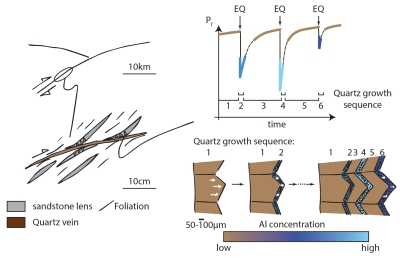Ask for a reprint
email :
* Give your email
2022
ACL
|
Hugues Raimbourg, Vincent Famin, Aurélien Canizarès, Emmanuel Le Trong, 'Fluid pressure changes recorded by trace elements in quartz', Geochemistry, Geophysics, Geosystem (2022) doi:10.1029/2022gc010346
Fluid pressure is a key parameter in earthquake mechanics, controlling seismic failure and plate coupling in convergent zones. Yet fluid pressure is also extremely difficult to quantify at seismogenic depth, which limits our knowledge of the stress state in accretionary prisms. Here, we show that the geochemical record of exhumed hydrothermal quartz veins may be used to place quantitative bounds on fluid pressure variations in subduction zones. The studied veins come from sediments accreted and exhumed by plate convergence in southwestern Japan. Quartz in veins displays growth rims of contrasted bright blue/dark brown cathodoluminescence (CL) colors, high/low Al concentrations, and low/high fluid inclusion densities. Because Si-Al substitution (and charge compensation by Li) strongly depends on the rate of quartz precipitation and Si solubility, Al-Li concentrations must be sensitive to fluid pressure. This is confirmed by fluid inclusions, the density of which, converted into trapping pressures, record fluid pressure drops by up to ∼70 MPa from CL-brown, Al-Li-poor rims to CL-blue, Al-Li-rich quartz rims. CL-blue rims grow at a fast rate, high Si supersaturation and low fluid pressure whereas CL-brown rims grow at a slower pace, lower Si supersaturation, and higher pressure. Quartz trace element chemistry thus offers a promising tool to quantify deep fluid pressure variations and their relationships to earthquakes
|

|